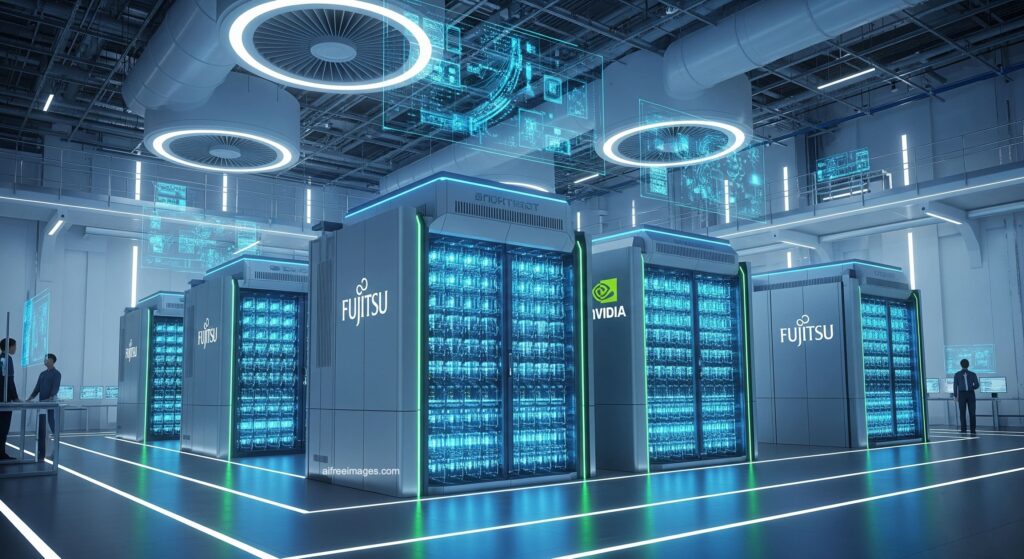The Fugaku succession marks the beginning of a new era in supercomputing: integrated AI + HPC on a single platform capable of rivaling the US and Europe.
A strategic project: from Fugaku to FugakuNEXT
The supercomputer Fugaku, inaugurated in 2020 and built by RIKEN and Fujitsu, achieved global leadership with 442 petaflops (FP64) on LINPACK and up to 2 exaflops in mixed precision. However, advances in AI and the need for more complex simulations have driven Japan to design its successor: FugakuNEXT.
This new system is expected to be operational by 2030 and will feature:
- FUJITSU-MONAKA-X CPU, an evolution of the current MONAKA, with more cores, extended SIMD, and an AI matrix engine.
- Next-generation NVIDIA GPU, with high bandwidth designed for generative AI workloads and parallel simulations.
- Goal of up to 600 EFLOPS in FP8 (sparse), positioning it as the world’s first zettascale supercomputer.
- A 100x boost in application performance compared to Fugaku, with similar energy consumption (~40 MW).
The key: AI and simulation in a unified workflow
FugakuNEXT aims not only to be faster in classical calculations but also to become a hybrid AI + HPC platform, where:
- AI accelerates simulations through surrogate models (PINNs, surrogate models).
- Mixed-precision calculations (FP16, FP8) complement double precision (FP64).
- Algorithms enable generative AI for science, such as materials design, drug discovery, or seismic prediction.
In essence: it’s not about keeping AI separate from HPC, but about fusing them into a single execution environment.
Global comparison: where does Japan stand against the US and Europe?
| Supercomputer | Country | CPU | GPU/Accelerator | Performance (LINPACK FP64) | AI Performance (FP16/FP8) | Approx. Power Consumption |
|---|---|---|---|---|---|---|
| FugakuNEXT (2030) | Japan | FUJITSU-MONAKA-X (Arm) | NVIDIA (next-gen) | >1500 PFLOPS (estimated) | >600 EFLOPS FP8 (sparse) | ~40 MW |
| Frontier | US | AMD EPYC Genoa | AMD Instinct MI250X | 1,102 PFLOPS | 6+ EFLOPS | ~21 MW |
| Aurora | US | Intel Xeon Max | Intel GPU Max | ~1 EFLOPS (deployed) | 10+ EFLOPS | ~30 MW |
| LUMI | EU/Finland | AMD EPYC Trento | AMD Instinct MI250X | 380 PFLOPS | ~2 EFLOPS | ~12 MW |
| JUPITER (2026) | EU/Belgium | SiPearl Rhea (Arm) + CXL | NVIDIA + accelerators | >1 EFLOPS | 50+ EFLOPS | ~20 MW |
| MareNostrum 5 | EU/Spain | Intel Xeon + NVIDIA GPUs | NVIDIA Hopper | 314 PFLOPS | 2–3 EFLOPS | ~10 MW |
Key points from the table:
- US already operates in the exascale range (Frontier).
- Europe is making strong progress with JUPITER, its first exaflop, scheduled for 2026, with a clear focus on AI.
- Japan aims to leap directly to zettascale, avoiding falling behind the US and EU.
Technical challenges of FugakuNEXT
- Energy consumption: maintaining 40 MW while increasing performance by 100x requires disruptive efficiency improvements in CPU-GPU and memory technologies.
- CPU-GPU integration: MONAKA-X and NVIDIA need to communicate with low latency and extremely high bandwidth, possibly with new interconnects like CXL/Infinity/NVLink evolution.
- Software and ecosystem: RIKEN is preparing a “virtual Fugaku,” accessible via the cloud, for the scientific community to optimize applications before 2030.
- HPC-AI-Quantum: Japan plans to combine FugakuNEXT with future Fujitsu quantum computers (>10,000 physical qubits expected by 2030).
Opinion: a strategic move?
Japan’s leap is as bold as it is ambitious. While the US and Europe advance step by step with exaflop + AI, Japan aims for a “disruptive leap” into the zettascale era.
If FugakuNEXT delivers on its promises, it could become the global benchmark in:
- Climate and seismic simulations (critical for a country like Japan).
- Life sciences (protein and drug design).
- Generative AI for science (hypothesis automation and experimental design).
However, if it stumbles, there’s a risk that the US with NVIDIA/AMD/Intel and Europe with JUPITER will outpace it before its launch.
FAQs
1. How does FugakuNEXT differ from Frontier or Aurora?
FugakuNEXT focuses not only on classical HPC simulation but on fusing AI + HPC as an integrated system aiming for zettascale performance in mixed workloads.
2. What role does NVIDIA play in the project?
It will design the accelerative GPUs, key for generative AI workloads and massive parallel processing, reinforcing its global AI dominance.
3. Can Japan lead against the US and Europe?
Success hinges on fulfilling promises of 100x gains in real applications and maintaining energy efficiency. If achieved, FugakuNEXT will set a new standard.
4. What impact will it have on the scientific community?
An open ecosystem is expected, with cloud access to “virtual” versions of the system before 2030, enabling researchers to adapt their software in advance.

